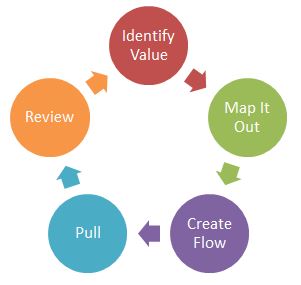Because Santa’s workshop must operate at maximum efficiency, he has employed the use of Lean methodology, or so I am told. Despite having an endless supply of elves and reindeer who work for gingerbread and candy canes, he must ensure that everything runs smoothly for Christmas Day. It’s because of this that he leverages Lean to reduce waste and continually improves his processes to deliver customer value, which is Leans main focus.
Santa, who has an unmatched understanding of his customer base, (you better watch out… you know the song) is able to focus his attention on his processes to constantly improve service delivery. Santa can maximize value by looking at the big picture rather than the components that drive it such as teams, technology or assets. As we all know, Santa knows what questions to ask and this sometimes is more important the having all the right answers.
The North Pole workshop follows a five-step thought process to guide them through lean thinking.

Identify Value
Ask any kid what the value is on Christmas morning and I am sure they will go on for hours explaining all the benefits. However, when we are looking at Lean we are thinking in terms of identifying the value stream. As the main purpose of Lean is to reduce waste we are looking to ensure that all services provide value, and all that do not are eliminated.
Map It Out
Santa and his team have been through enough Christmas Eves to know what good and bad look like. So they have had a chance to map out what the process should look like to get it all done in one night globally. For the rest of us we need to employ value stream mapping to identify in a visual way which of the activities do and do not provide that value by representing each activity that happens in a given process
Create Flow
Since Santa only has one night, it it imperative to eliminate any component of the flow that impedes delivery of gifts and thus value. The key here is that while we want to focus on not creating waste we must also balance to ensure that there is flow in the process. After all, while an approach may make sense to the elves there may be unforeseen side effects for Santa on delivery day.
Pull
The kids get the value in the morning (provided they were good) in the gifts they receive and full stockings. In other words we don’t assume to provide gifts to everyone, only the kids that are good – thus the pull.
To break this into terms we may relate to, a pull is like a service request. The initial request is from the consumer of the service and depending on the level of automation may have subsequent work-flowed requests to complete the initial business need.
The reason that focus is placed on pull is that push tends to introduce waste through potential assumptions or delivery of service based on the needs of the provider rather than the business or consumer
Review
On Boxing Day Santa and team complete a review of the night and make new process adjustments to minimize waste. As Santa puts it “It’s like wringing out the wash cloth a few times over to get it as dry as possible”
Granted there are going to be some challenges along the way….
One such pitfall to watch out for is that while you need to commit to this methodology. As you become more efficient you discover more issues to address, you perform a review and, well the cycle continues. The commitment to this must be for the long haul so that there is sufficient time to make the improvements and to continue to drive out further areas of waste.
So, why did Santa implement a Lean methodology? Clearly he was looking to minimize costs. His location suggests that the real estate, while in a remote location provided the best value, the elves work for sugary treats. There is also the fact that there is no incoming cash flow. No kickbacks or endorsement deals for this outfit. If you were working for cookies and milk you might be inclined to be leaner as well even if your waist line is not.
